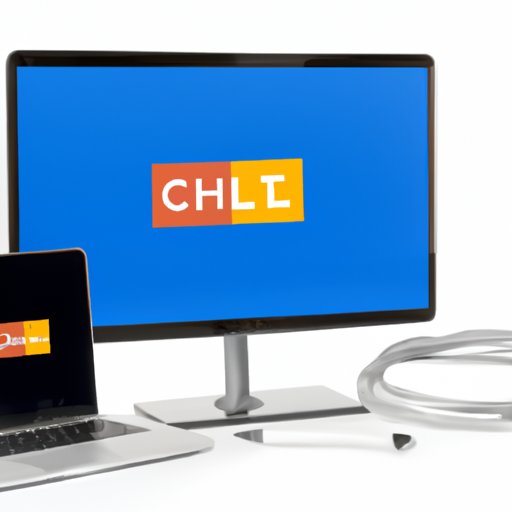I. Introduction
Are you tired of watching your favorite movies and shows on a small laptop screen? Do you want to experience an immersive entertainment experience? Look no further than casting your laptop to a TV! In this article, we will provide a step-by-step guide to casting your laptop to a TV, compare different methods, and troubleshoot common issues that arise during the process. This article is designed for anyone who wants to expand their entertainment horizons using their laptop.
II. Importance of Casting a Laptop to a TV
Casting your laptop to a TV has several benefits. Firstly, you get a larger screen size, which translates to a better viewing experience. Secondly, most TVs have better sound quality than laptops, which enhances your entertainment experience. Finally, you can easily access your streaming content on a big screen without having to squint at a small laptop display.
To put it into perspective, imagine you want to binge-watch your favorite show. You probably want to see it on the biggest screen possible, right? Now imagine watching it on a tiny laptop screen, with less powerful speakers and uncomfortable seating arrangement. Sounds terrible, right? By casting your laptop to a TV, you can transform your viewing experience and take it to a whole new level.
III. Comparison of Different Methods
There are multiple methods of casting your laptop to a TV, and each has its pros and cons. Here’s a brief comparison:
Screen Mirroring: This method involves mirroring your laptop’s screen onto your TV without using any cables. Most modern smart TVs have in-built technology that enables screen mirroring. Pros: No wires required, easy connectivity. Cons: The picture may lag, Poor sound quality.
HDMI Cable: An HDMI cable connects your laptop to your TV, providing a high-quality image and sound. Pros: Excellent picture and audio quality. Cons: Limited mobility, can’t connect to TVs without an HDMI port.
Chromecast: This device connects to your TV’s HDMI port and allows you to stream videos and movies from your laptop, tablet or smartphone. Pros: Wireless connectivity, can stream from various devices, easy set-up. Cons: Requires Wi-Fi network.
Wireless Casting: This method enables you to connect your laptop to a TV without cables using a wireless display adapter. Pros: No cables required, excellent picture quality. Cons: May experience connectivity issues.
Based on the comparison above, select a method that suits your needs best and prepare any necessary equipment you need before proceeding.
IV. Step-by-Step Guide
Now that you have chosen a method let’s get started! Here’s a step-by-step guide to casting your laptop to your TV:
Step 1: Check compatibility. Ensure that your TV supports the connectivity method you have chosen. Some older TVs may not support newer wireless casting technologies. You may need to purchase an additional adapter to ensure compatibility.
Step 2: Connect your laptop and TV. If you’re using an HDMI cable, plug one end of the cable into the HDMI port on your laptop and the other end into your TV’s HDMI port. If you’re using a wireless method, connect the adapter to your laptop. Ensure the adapter is properly plugged in.
Step 3: Turn on your laptop and TV. Ensure both devices are turned on before proceeding.
Step 4: Select the correct input on your TV. Switch to the input that corresponds to your laptop, or you may need to go into your TV’s settings and select your laptop’s name from the list of connected devices.
Step 5: Cast your laptop’s screen. Follow the instructions for your chosen casting method to pair your laptop with your TV. For instance, if you’re using screen mirroring, the TV will display a code you must enter on your laptop to pair the devices. If you’re using Chromecast, download the Chromecast app on your laptop and select the cast button.
Step 6: Enjoy! Once you have paired your devices, you can start watching your favorite shows and movies on the big screen!
Note: The exact process of casting a laptop to a TV varies depending on the method you choose. Use the manufacturer’s instructions for specific details.
V. Troubleshooting Guide
Despite the convenience of casting laptops, the process may still frustrate users from time to time. Here are some common issues that come up with casting a laptop to a TV and ways to solve them:
Connectivity problems: Ensure both devices are connected to the same Wi-Fi network. If the TV fails to detect your laptop, unplug the adapter, restart both devices, then retry connection.
Sound output issues: If your laptop speakers continue to play audio while the video has moved to the TV, access the audio settings on your laptop and direct them to your TV to fix it.
Unsupported file formats: If playing a video on your laptop results in a black screen on your TV, the file format may not be compatible with your screen casting method or device. Therefore, you should convert the file to a compatible format or use a different screen-casting method. Try to match the TV’s native resolution to the video settings on your laptop.
VI. Video-Based Guide
If you feel overwhelmed by the instructions provided above, we’ve got you covered with a video tutorial that takes the guesswork out of casting your laptop to a TV. Watch this visual guide and follow step-by-step instructions to achieve a seamless connection:
Video URL:
VII. Conclusion
In conclusion, casting your laptop to a TV allows you to open up a world of possibilities for home entertainment. With the various methods available, you can choose the one that’s best for you and have an immersive, high-quality viewing experience every time. Remember to troubleshoot any issues that occur and seek support if necessary.
